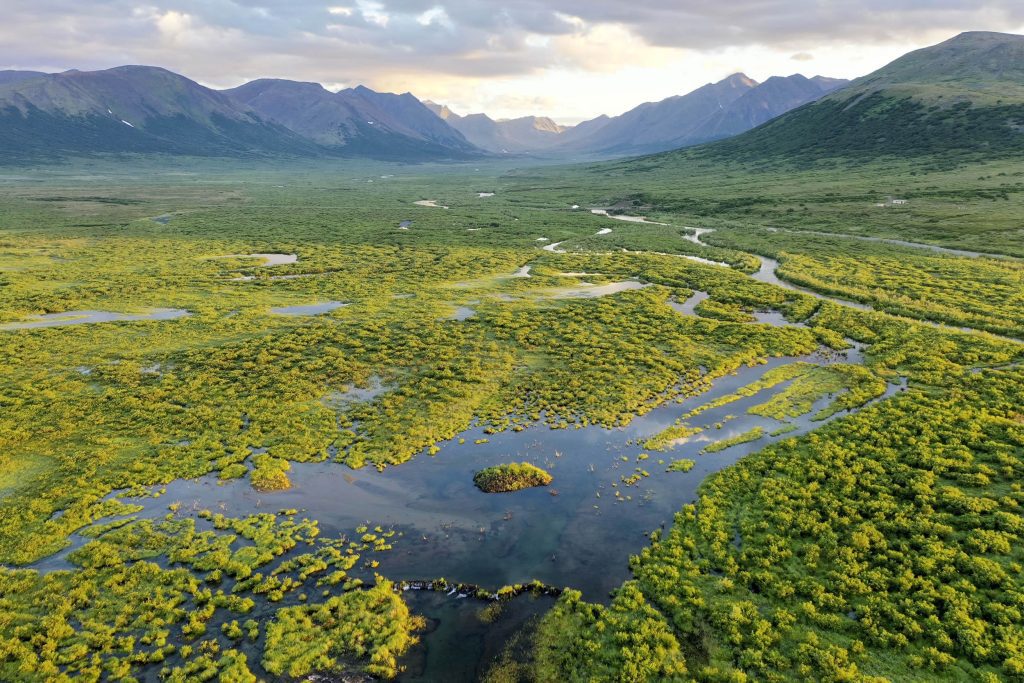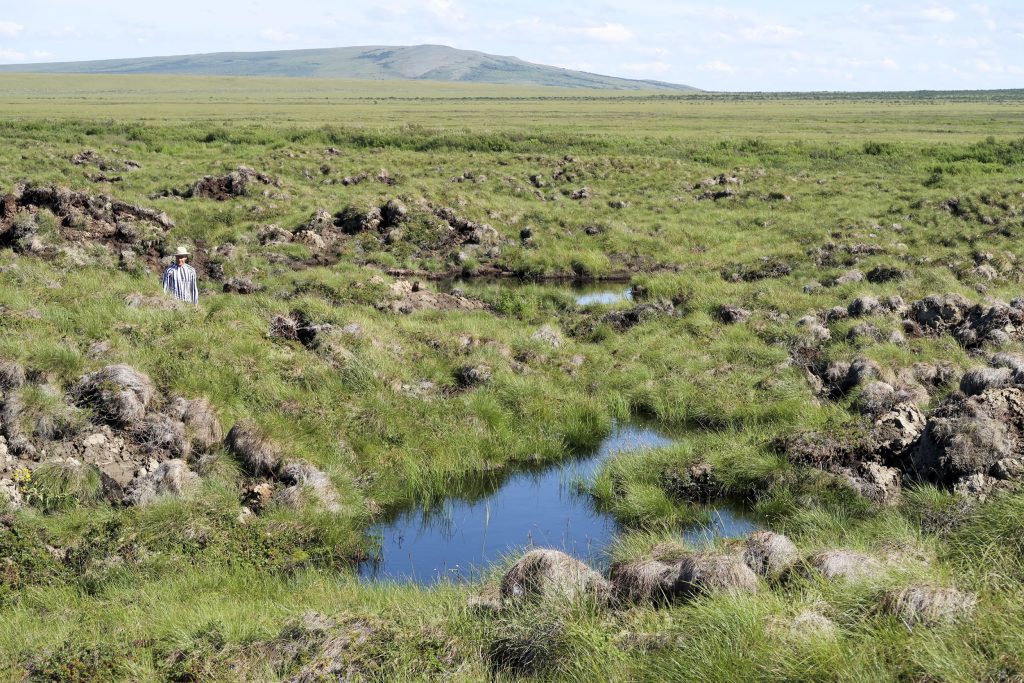K. D. Tape1, J. A. Clark1, B. M. Jones2, H. C. Wheeler3, P. Marsh4, and F. Rosell5
1Geophysical Institute, University of Alaska Fairbanks, Fairbanks, AK, USA
2Water and Environmental Research Center, Institute of Northern Engineering, University of Alaska Fairbanks, Fairbanks, AK, USA
3School of Life Sciences, Anglia Ruskin University, Cambridge, UK
4Department of Geography, Wilfrid Laurier University, Waterloo, ON, Canada
5Department of Natural Sciences and Environmental Health, University of South-Eastern Norway, Bø, Norway
Highlights
- Recent satellite imagery and older aerial photography show that North American beavers (Castor canadensis) are colonizing the Arctic tundra of Alaska, with over 12,000 ponds thus far counted in western Alaska, a doubling of ponds since 2000.
- In Canada, beaver pond mapping is underway, complemented by scattered observations of recent changes. Eurasian beavers (C. fiber) are rebounding in Asia but remain south of the Arctic tundra in most locations.
- The Arctic Beaver Observation Network was established in 2020 to help integrate, guide, and disseminate information concerning beaver range expansion into tundra regions and implications for ecosystems and resources.
Introduction
Research on North American beaver (Castor canadensis) engineering in the Arctic has made great strides in recent years, but most of the work lies ahead. Over the last several decades, people in remote Alaska communities have observed an influx of beavers (ADF&G Reports 1965-2017). We quantified this trend by using satellite imagery to detect beaver pond formation in Alaska tundra regions, mapping approximately 12,000 beaver ponds (e.g., Fig. 1, right panel), including a doubling in most areas during the last 20 years (Tape et al. 2021). We showed that new beavers are controlling surface water increases, which affects underlying permafrost (Jones et al. 2020). Fieldwork is underway to characterize the impacts of beaver ponds on aquatic and terrestrial Arctic ecosystems, starting with hydrology and permafrost, and continuing downstream to methane flux, fish populations, and aquatic food webs. As a result of these efforts, most of the questions surrounding beaver engineering in the Arctic are presently being examined but are unanswered. To coordinate research and action among stakeholders in the circumarctic region, the Arctic Beaver Observation Network (A-BON) was formed in 2020 and a synthesis effort is underway to identify knowledge gaps and support the integration of different approaches and perspectives.


Tundra be dammed
In 2016 we imagined that beaver distribution and possible dispersal in the Arctic could be identified by mapping beaver ponds in satellite imagery and older aerial photography through time. Initial studies confirmed our suspicions (Tape et al. 2018), as did the observations of local people in northwest Alaska, who have been observing the influx of beavers for a half-century (ADF&G Reports 1965-2017). Yet the scale and magnitude of this new disturbance regime was unknown in Alaska and the circumarctic. We have since mapped approximately 12,000 beaver ponds (using 2015-19 imagery) in Arctic tundra of Alaska (e.g., Fig. 2). This mapping excludes southwest Alaska tundra and thus provides an underestimate of the total number of beaver ponds. Most areas show a doubling of beaver ponds in the last 20 years (Tape et al. 2021). In 1949-55 aerial photography covering coastal areas of western Alaska, there are no detectable beaver ponds. Stream by stream and floodplain by floodplain, beavers are transforming lowland tundra ecosystems. Increased vegetation productivity (see essay Tundra Greenness) and the expansion of woody shrubs (Myers-Smith et al. 2015) due to climate change has created more forage and dam construction materials, translating to more favorable habitat. The increase in winter stream discharge (St. Jacques and Sauchyn 2009) also implies greater aqueous habitat. Finally, the earlier end of winter and onset of spring (see essay Terrestrial Snow Cover), when beavers can again begin foraging, effectively shortens what is presumably the most challenging time in the annual life cycle of beavers. It remains unclear whether beaver colonization of the Arctic is occurring due to climate change ameliorating habitat or a decrease in trapping pressure, or some combination of both.


In Canada, beaver distribution changes have also been observed both by local people and scientists. Concern over rising numbers of beavers in the Inuvialuit settlement region in the Northwest Territories in northwestern Canada was sufficient to instigate a harvesting incentive scheme in 2017. Although publications of academic studies of beavers in northern Canada have been sparse to date, there are reports of beavers north of the previously known range (Jung et al. 2016).
In Europe, Eurasian beavers (C. fiber) were widespread from the Arctic to the Mediterranean, before being substantially reduced around the twelfth century, and almost extinct by the sixteenth century. Today, the Eurasian beaver has restored a large area of its original range, and increased in numbers from around 1200 beavers a century ago to an estimated 1.5 million individuals today; beavers distribution reaches the northern coast throughout most of Europe (Halley et al. 2021). In Asia, beaver distribution remains well south of Arctic tundra regions, though recent northward range extensions have been observed (Halley et al. 2021). In general, research on beavers in Arctic tundra regions is in its early stages. A coordinated circumarctic beaver pond mapping effort is underway, which will hopefully establish the footprint, if not the nature, of this new disturbance regime in the Arctic.
Implications of beaver engineering in the Arctic
Beavers are a keystone species whose engineering is known to heavily influence streams, rivers, riparian corridors, and lakes in North America, Eurasia, and South America (Whitfield et al. 2015). Beavers are known to dramatically change the landscapes they inhabit by harvesting shrubs, saplings, and trees, which they use to construct dams, inundate the surrounding landscape, and create their watery world. Beavers build lodges of mud and vegetation in water that is deep enough for an underwater entrance that remains unfrozen and permits access for them, but not predators. By constructing dams, beavers severely alter the stream flow regime, which facilitates the arrival of new species, including riverine plants, invertebrates, and fish (Bunn and Arthington 2002). Beaver ponds in temperate ecosystems enhance aquatic habitat complexity and biodiversity.
It remains unclear how these impacts will be manifest in the Arctic, where low water temperatures inhibit stream productivity and biodiversity, and where permafrost holds much of the soil together. People living in remote communities are concerned for resources such as fish, water quality, and boat access (Moerlein and Carothers 2012). In an area of northwest Alaska with exceptional satellite imagery coverage, we discovered that beavers are the dominant factor (66%) controlling increases in surface water extent (Jones et al. 2020), which thaws underlying permafrost as it inundates tundra vegetation. Beaver dams divert flow, sometimes catastrophically when they fail, and can thaw and destabilize the landscape (Lewkowicz and Coultish 2004) through fluvio-erosional and thermokarst processes (Fig. 3). Thawing of permafrost associated with new beaver ponds would initially release carbon and methane stored in permafrost, though the magnitude and fate of these fluxes are complex and unknown. Permafrost thaw, thermokarst, and the inception of a more dynamic lowland Arctic ecosystem suggest an exacerbation of effects due to warming air temperatures. As beavers create thermal and biological oases by the thousands, they could provide a foothold for boreal aquatic species, including fish and aquatic invertebrates. For now, however, these remain hypotheses that will spawn downstream studies involving field measurements and local knowledge to answer.


Arctic Beaver Observation Network (A-BON): Tracking a new disturbance
Recognizing an impending need to understand the scale, dynamics, and effects of beaver engineering in the tundra, individuals and organizations joined forces across Alaska, Canada, and Eurasia to identify key questions and involve stakeholders and land managers. A-BON involves natural scientists, social scientists, tribal entities and local observers, and agency land managers across the Arctic. A-BON has working groups in Alaska, Canada, Europe, and Asia.
The initial goals of A-BON are to (1) include diverse backgrounds and establish working relationships, (2) identify key questions for study, (3) align study designs and observation methods, (4) facilitate co-production of knowledge between scientists and local observers, (5) understand stakeholder land/resource management objectives, (6) assemble an expert steering committee to advise other Arctic science bodies (e.g., Conservation of Arctic Flora & Fauna, Circumpolar Biodiversity Monitoring Program), and (7) synthesize, archive, and disseminate relevant and co-produced data. These goals are actively being refined.
A synthesis effort underway within A-BON aims to identify key questions and knowledge gaps surrounding beaver colonization in the tundra across natural and social scientists, Indigenous organizations and observers, and land managers. Preliminary results demonstrate the breadth of interests and concerns, spanning beaver ecology, biophysical and socio-cultural impacts, local and Indigenous knowledge, management, and adapting to the evolving relationships with beavers. A-BON will discuss these and other efforts at the first meeting in March 2022 in Fairbanks, Alaska (could be virtual). We welcome participation in A-BON from anyone with interest in the topic.
Acknowledgments
K. Tape, J. Clark, and B. Jones acknowledge NSF OPP #1850578 and #2114051. H. Wheeler acknowledges the UK-Canada Arctic partnership bursary (NERC/BEIS) and Anglia Ruskin Next Steps QR fund.
References
ADF&G, 1965-2017: ADF&G (Furbearer) Reports. Alaska Department of Fish & Game, Division of Wildlife Conservation, Juneau, Alaska.
Bunn, S. E., and A. H. Arthington, 2002: Basic principles and ecological consequences of altered flow regimes for aquatic biodiversity. Environ. Manage., 30(4), 492-507, https://doi.org/10.1007/s00267-002-2737-0.
Halley, D. J., A. P. Saveljev, and F. Rosell, 2021: Population and distribution of beavers Castor fiber and Castor canadensis in Eurasia. Mammal Rev., 51, 1-24, https://doi.org/10.1111/mam.12216.
Jones, B. M., K. D. Tape, J. A. Clark, I. Nitze, G. Grosse, and J. Disbrow, 2020: Increase in beaver dams controls surface water and thermokarst dynamics in an Arctic tundra region, Baldwin Peninsula, northwestern Alaska. Environ. Res. Lett., 15(7), 075005, https://doi.org/10.1088/1748-9326/ab80f1.
Jung, T. S., J. Frandsen, D. C. Gordon, and D. H. Mossop, 2016: Colonization of the Beaufort coastal plain by Beaver (Castor canadensis): a response to shrubification of the Tundra? Can. Field Nat., 130(4), 332-335, https://doi.org/10.22621/cfn.v130i4.1927.
Lewkowicz, A. G., and T. L. Coultish, 2004: Beaver damming and palsa dynamics in a subarctic mountainous environment, Wolf Creek, Yukon Territory, Canada. Arct. Antarct. Alp. Res., 36, 208-218, https://doi.org/10.1657/1523-0430(2004)036[0208:bdapdi]2.0.co;2.
Moerlein, K. J., and C. Carothers, 2012: Total environment of change: impacts of climate change and social transitions on subsistence fisheries in northwest Alaska. Ecol. Soc., 17(1), 10, https://doi.org/10.5751/es-04543-170110.
Myers-Smith, I. H., and Coauthors, 2015: Climate sensitivity of shrub growth across the tundra biome. Nat. Climate Change, 5(9), 887-891, https://doi.org/10.1038/nclimate2697.
St. Jacques, J. -M., and D. J. Sauchyn, 2009: Increasing winter baseflow and mean annual streamflow from possible permafrost thawing in the Northwest Territories, Canada. Geophys. Res. Lett., 36(1), L01401, https://doi.org/10.1029/2008gl035822.
Tape, K. D., B. M. Jones, C. D. Arp, I. Nitze, and G. Grosse, 2018: Tundra be dammed: Beaver colonization of the Arctic. Glob. Change Biol., 24(10), 4478-4488, https://doi.org/10.1111/gcb.14332.
Tape, K. D., J. A. Clark, and B. M. Jones, 2021: Beaver Pond Locations in Arctic Alaska, 1949 to 2020. Arctic Data Center. Accessed 15 September 2021, https://doi.org/10.18739/A2QR4NR6D.
Whitfield, C. J., H. M. Baulch, K. P. Chun, and C. J. Westbrook, 2015: Beaver-mediated methane emission: The effects of population growth in Eurasia and the Americas. Ambio, 44(1), 7-15, https://doi.org/10.1007/s13280-014-0575-y.
December 2, 2021
